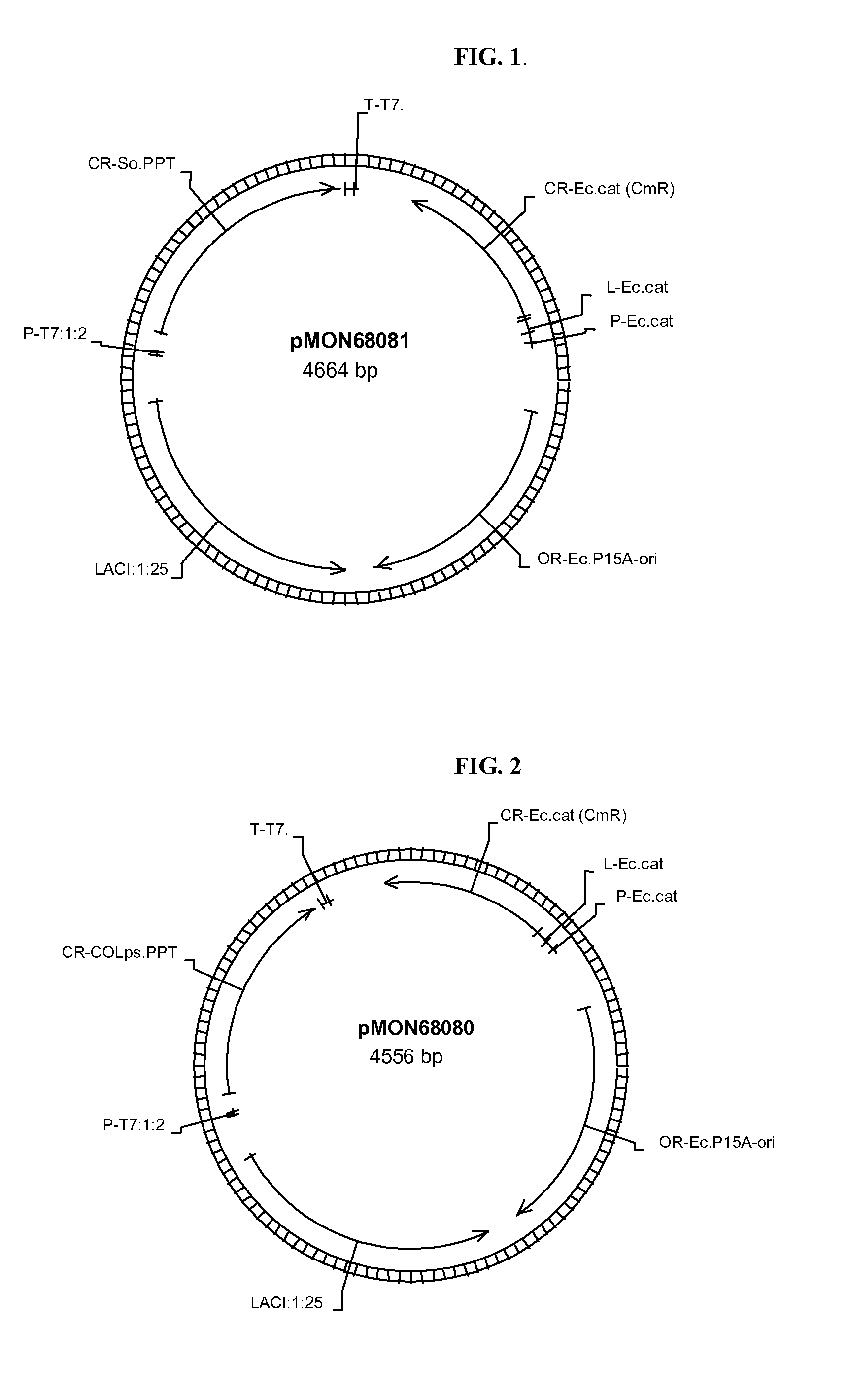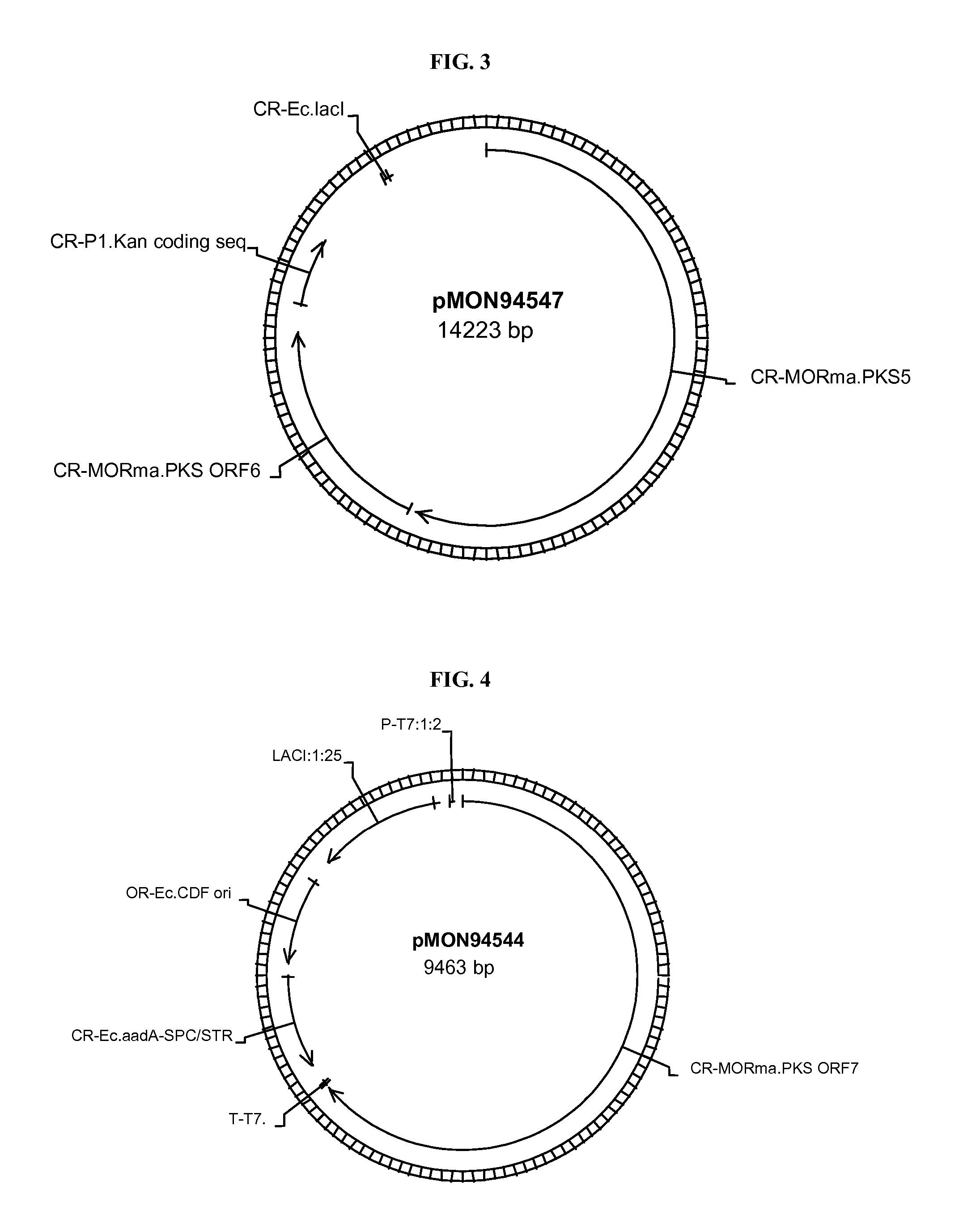Phosphopantetheinyl transferases from bacteria
- Summary
- Abstract
- Description
- Claims
- Application Information
AI Technical Summary
Benefits of technology
Problems solved by technology
Method used
Image
Examples
example 1
Cloning of Phosphopantetheinyl Transferase Sequences
[0118] Three bacterial phosphopantetheinyl transferases were cloned. The amino acid sequence of the phosphopantetheinyl transferase (Ppt) from Shewanella SCRC-2738 (SEQ ID NO:17) was used to search public databases for novel ppts that function in EPA or DHA biosynthesis. This search yielded putative ppts from Shewanella oneidensis MR-1 (SEQ ID NO:1) (So-ppt) and Colwellia psychrerythraea (SEQ ID NO:3) (Cp-ppt). The nucleic acid sequences of ppts from Shewanella oneidensis MR-1 (SEQ ID NO:2) and Colwellia psychrerythraea (SEQ ID NO:4) were cloned using the Expand High Fidelity PCR system (Roche, Applied Science, Indianapolis, Ind.) with the following primer pairs:
Shew new(SEQ ID NO:9)5′: tcgagctcgcatatgaagattgagcttttttttataccShew(SEQ ID NO:10)3′: tcttaattaattagtcagccaaactagccgcColwe new(SEQ ID NO:11)5′: tcgagctcgcatatgacttctttttctcaatctgColwe(SEQ ID NO:12)3′: tcttaattaattagatttcctgataaccaagtag.
[0119] The genes were amplified for ...
example 2
Expression of Phosphopantetheinyl Transferase Sequences in Escherichia coli
[0126] To demonstrate functionality of the ppts described in Example 1, the Moritella marina polyketide synthase (PKS) genes were cloned into the Novagen pDUET vectors (EMD, Biosciences, Darmstadt, Germany), a set of 4 compatible E. coli expression vectors. This PKS consists of 4 polypeptides encoded by the nucleic acids orf5 (SEQ ID NO:20), orf6 (SEQ ID NO:22), orf7 (SEQ ID NO:24) and orf8 (SEQ ID NO:26), which are described as orf6, orf7, orf8, and orf9 in U.S. Pat. No. 6,140,486, respectively. The expression vectors pMON94547 (Orf5 and Orf6) (FIG. 3), pMON94544 (Orf7) (FIG. 4) and pMON94534 (Orf8) (FIG. 5) were constructed using 3 of the pDUET vectors. The fourth pDUET vector was used for ppt expression.
[0127] To obtain an enzymatically active PKS, the Orf5 expression product requires pantethenylation, which is catalyzed by the Ppt. Each of the bacterial ppts was cloned into pACYC-DUET-1. The constructio...
example 3
Expression of Phosphopantetheinyl Transferase Sequences in Plants
[0130] To demonstrate the ability of the M. marina PKS, including the M. marina ppt, to synthesize DHA in plants, several plant expression cassettes were generated. The genes for orf5-8 were modified for expression in dicotyledonous plants. It is known that non-endogenous protein-encoding sequences may not express well in plants (U.S. Pat. No. 5,880,275, herein incorporated by reference). Therefore, using the native PKS polypeptide sequences for Orfs5-8 (SEQ ID NOs: 19, 21, 23, and 25), artificial protein-encoding polynucleotide sequences were designed and constructed by 1) using a codon usage bias similar to that of highly expressed soybean proteins, and by 2) removal of RNA destabilizing elements previously characterized and known to affect mRNA stability in planta (U.S. Pat. No. 5,880,275) and by introducing a Kozak sequence prior to the ATG start codon (Joshi et al., 1997). The resulting modified polynucleotide se...
PUM
| Property | Measurement | Unit |
|---|---|---|
| Temperature | aaaaa | aaaaa |
| Fraction | aaaaa | aaaaa |
| Fraction | aaaaa | aaaaa |
Abstract
Description
Claims
Application Information
 Login to View More
Login to View More - R&D
- Intellectual Property
- Life Sciences
- Materials
- Tech Scout
- Unparalleled Data Quality
- Higher Quality Content
- 60% Fewer Hallucinations
Browse by: Latest US Patents, China's latest patents, Technical Efficacy Thesaurus, Application Domain, Technology Topic, Popular Technical Reports.
© 2025 PatSnap. All rights reserved.Legal|Privacy policy|Modern Slavery Act Transparency Statement|Sitemap|About US| Contact US: help@patsnap.com



